April 16, 2023
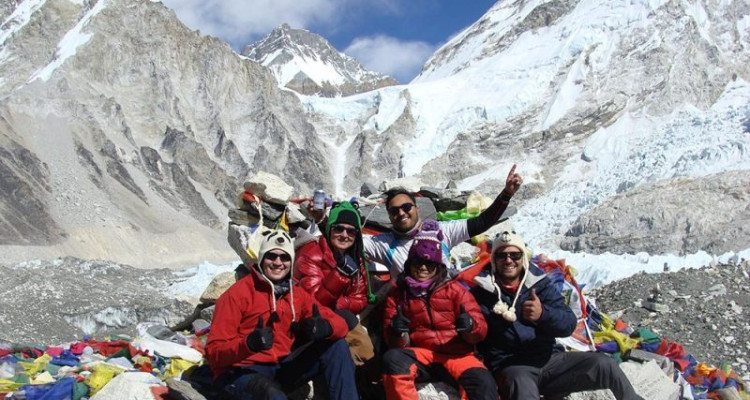
12 Days Everest Base Camp trek itinerary is one of the most popular and breathtaking treks in Nepal. This trek is on the bucket list of many adventure enthusiasts and travelers. However, it requires proper planning and guidance to make it a successful and memorable experience. This is where Safe Holiday Adventure comes into the picture.
Safe Holiday Adventure is a local travel company in Nepal that provides exceptional trekking services to its clients. They have over a decade of experience in organizing treks and expeditions in the Himalayas. With their expert team of guides and porters, they ensure that your trek to Everest Base Camp is safe, comfortable, and enjoyable.
The company offers a range of packages to choose from, including the Everest Base Camp Trek, Everest Base Camp Short Trek, and Everest Base Camp Helicopter Trek. All the packages are designed to suit the needs and preferences of the trekkers. The trek packages include airport pick-up and drop-off, accommodation in tea houses or lodges, all meals during the trek, and necessary permits and fees. They also provide trekking gear on rent, including sleeping bags, down jackets, and trekking poles.
One of the highlights of Safe Holiday Adventure is their experienced guides. They have a team of knowledgeable and skilled guides who have been trekking in the Himalayas for many years. These guides are fluent in English and other languages, making communication easy and comfortable for the trekkers. They have a deep understanding of the local culture and traditions, and they will be happy to share their knowledge and stories with you during the trek. They also prioritize safety and take necessary precautions to ensure that the trekkers are safe and sound throughout the trek.
The Everest Base Camp Trek is a challenging trek that requires physical fitness and mental stamina. However, with the help of Safe Holiday Adventure, you can accomplish this trek with ease. They provide a comprehensive pre-trek briefing, which includes information on altitude sickness, acclimatization, and trekking dos and don’ts. They also offer support and encouragement throughout the trek, making the trekking experience more comfortable and enjoyable.
Moreover, Safe Holiday Adventure ensures that the trek is eco-friendly and sustainable. They encourage responsible tourism practices, such as carrying your trash, avoiding single-use plastics, and respecting the local culture and traditions. They also support local communities by hiring local guides and porters and promoting local products.
In conclusion, if you are planning to trek to 12 Days Everest Base Camp trek itinerary ,Safe Holiday Adventure is the perfect choice for you. With their exceptional services, experienced guides, and commitment to sustainability, they guarantee you a safe, comfortable, and enjoyable trekking experience.
Here is a sample Everest Base Camp Trek itinerary that takes around 14 days to complete:
Day 1: Arrival in Kathmandu
You will arrive in Kathmandu, the capital city of Nepal, where a representative from the travel company will pick you up from the airport and transfer you to your hotel. You can spend the rest of the day resting or exploring the city.
Day 2: Flight to Lukla and Trek to Phakding (2,652m)
After an early morning flight to Lukla, you will meet your trekking crew and start trekking towards Phakding. The trail follows the Dudh Koshi River and passes through beautiful villages and dense forests.
Day 3: Trek to Namche Bazaar (3,440m)
The trek today is relatively challenging as you climb steeply uphill to reach Namche Bazaar, a bustling Sherpa town that serves as the gateway to the Everest region.
Day 4: Acclimatization day in Namche Bazaar
You will spend a day in Namche Bazaar to acclimatize to the high altitude. You can explore the town and visit the local market, museums, and monasteries.
Day 5: Trek to Tengboche (3,870m)
The trail today passes through rhododendron forests and crosses the Imja Khola River before reaching Tengboche, a beautiful village that is home to the famous Tengboche Monastery.
Day 6: Trek to Dingboche (4,360m)
The trek today is challenging as you gain altitude and pass through alpine landscapes. You will also get stunning views of Mount Everest, Lhotse, and Ama Dablam along the way.
Day 7: Acclimatization day in Dingboche
You will spend a day in Dingboche to acclimatize to the high altitude. You can go for a short hike to the nearby hills to get stunning views of the mountains.
Day 8: Trek to Lobuche (4,940m)
The trek today is relatively short but challenging as you gain altitude and trek on a rocky terrain. You will get closer to the Khumbu Glacier and get stunning views of the surrounding mountains.
Day 9: Trek to Gorak Shep (5,160m) and Hike to Everest Base Camp (5,364m)
Today is the highlight of the trek as you reach Gorak Shep and hike to the Everest Base Camp. The trail is challenging and passes through the Khumbu Icefall. You will get stunning views of the surrounding mountains and glaciers.
Day 10: Hike to Kala Patthar (5,545m) and Trek to Pheriche (4,371m)
Today, you will wake up early in the morning and hike to Kala Patthar, a famous viewpoint that offers stunning views of Mount Everest and other surrounding peaks. After that, you will trek back to Pheriche.
Day 11: Trek to Namche Bazaar
The trek today is mostly downhill as you retrace your steps back to Namche Bazaar.
Day 12: Trek to Lukla
You will continue trekking downhill towards Lukla, where you will spend the night.
Day 13: Flight back to Kathmandu
You will take an early morning flight back to Kathmandu and spend the day exploring the city or relaxing at your hotel.
Day 14: Departure
You will be transferred to the airport for your flight back home or to your next destination.
Note: This is just a sample itinerary, and it can be customized based on your preferences and requirements.
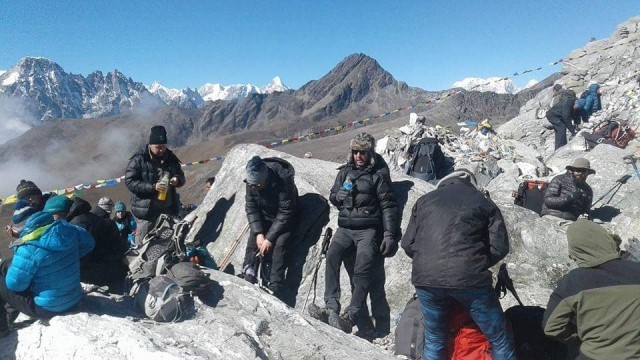
The Everest Base Camp Trek is a dream destination for many trekkers around the globe because it offers a unique combination of adventure, natural beauty, and cultural experience. Here are some reasons why:
Overall, the Everest Base Camp Trek is a dream destination for many trekkers because it offers a unique combination of adventure, natural beauty, and cultural experience, and provides a sense of personal achievement and fulfillment.
The best time to go to Everest Base Camp is during the pre-monsoon season (February to May) and the post-monsoon season (September to November). Here are some details about these seasons:
Overall, the best time to go to Everest Base Camp is during the pre-monsoon season (February to May) and the post-monsoon season (September to November), when the weather is dry, clear, and stable, and the trails are relatively less crowded.
The weather in the Everest Base Camp trek from Lukla to EBC varies depending on the season. Here’s a breakdown of the weather conditions you can expect during different seasons:
Overall, it’s essential to prepare for the weather conditions during your trek, regardless of the season. Make sure to pack appropriate clothing and gear, including warm layers, waterproof jackets and pants, and sturdy trekking boots, to ensure your safety and comfort during the trek.
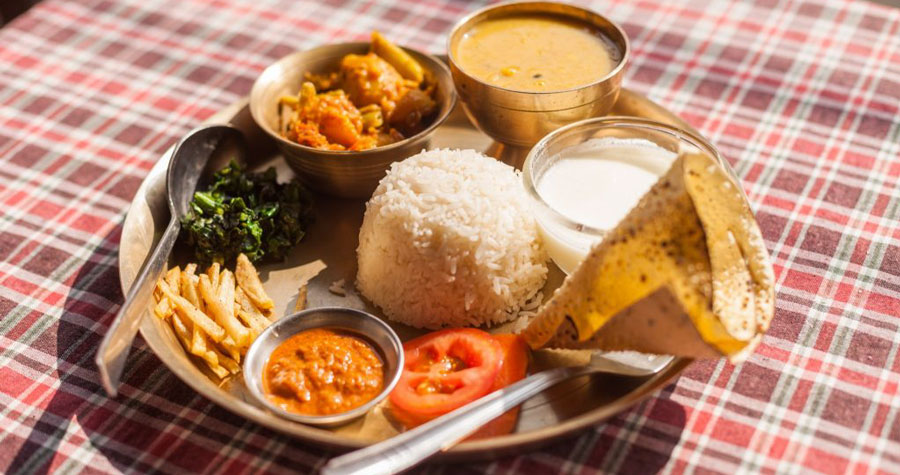
During the Everest Base Camp trek, meals and drinking water are essential aspects that you need to consider. Here are some important points to keep in mind:
The Everest Base Camp trek price can vary depending on several factors, such as the season, the duration of the trek, and the services included in the package. Here’s a rough estimate of the cost of the Everest Base Camp trek for European, African, and Asian trekkers:
It’s important to note that the prices mentioned above are rough estimates and can vary depending on the trekking company, the services included, and the season. It’s recommended to research and compare different trekking companies and packages to find the best price for your budget. Additionally, it’s essential to ensure that the trekking company you choose provides quality services and experienced guides to ensure a safe and enjoyable trekking experience.
The shortest Everest Base Camp Trek can be completed in 9-10 days, although this is a challenging and strenuous itinerary. Here is a basic outline of the itinerary:
Day 1: Fly from Kathmandu to Lukla and trek to Phakding (2610m)
Day 2: Trek from Phakding to Namche Bazaar (3440m)
Day 3: Trek from Namche Bazaar to Tengboche (3860m)
Day 4: Trek from Tengboche to Dingboche (4410m)
Day 5: Trek from Dingboche to Lobuche (4910m)
Day 6: Trek from Lobuche to Gorak Shep (5140m) and hike to Everest Base Camp (5364m)
Day 7: Hike to Kala Patthar (5550m) and return to Gorak Shep, then trek down to Pheriche (4270m)
Day 8: Trek from Pheriche to Namche Bazaar (3440m)
Day 9: Trek from Namche Bazaar to Lukla and fly back to Kathmandu.
Please note that this is a very condensed itinerary and doesn’t allow for much rest or acclimatization time. It is recommended that trekkers take more time to complete the trek and allow for additional rest days to properly acclimatize to the altitude.
The cost of the Everest Base Camp trek for Nepali tourists is generally lower than that for international tourists. The exact price can vary depending on several factors such as the season, duration of the trek, and the services included in the package. However, on average, the cost of the Everest Base Camp trek for Nepali tourists is around NPR 70,000 to NPR 100,000 per person for a 12-14 day trek, which is significantly lower than the cost for international tourists.
It’s important to note that the Nepali government has implemented special provisions for Nepali tourists to promote domestic tourism. For instance, Nepali tourists are exempt from paying the entrance fee for the Sagarmatha National Park, which is a significant cost for international tourists. Additionally, the government has also implemented a discounted rate for domestic flights, which can further reduce the overall cost of the trek.
Overall, the Everest Base Camp trek is a popular destination among Nepali tourists, and there are several trekking companies that offer quality services and experienced guides at reasonable prices. It’s recommended to research and compare different trekking companies and packages to find the best price for your budget. Additionally, it’s essential to ensure that the trekking company you choose provides quality services and experienced guides to ensure a safe and enjoyable trekking experience.
Sherpa Festival, also known as Mani Rimdu, is celebrated in the Everest region of Nepal every year in October or November. The festival takes place at Tengboche Monastery, which is located on the way to Everest Base Camp.
The festival lasts for three days and celebrates the victory of Buddhism over Bon, the pre-Buddhist religion of Tibet. During the festival, there are sacred dances, prayers, and rituals performed by the monks and lamas of the monastery.
To witness the Sherpa Festival, trekkers need to plan their itinerary accordingly so that they are in Tengboche at the right time. Usually, the festival falls on the tenth lunar month of the Tibetan calendar, which corresponds to October or November in the Gregorian calendar.
It is recommended to check with your tour operator or guide to confirm the exact dates of the festival and to make arrangements to attend.
The cost of the Everest Base Camp trek for Indian tourists is generally lower than that for international tourists from other countries. The exact price can vary depending on several factors such as the season, duration of the trek, and the services included in the package. However, on average, the cost of the Everest Base Camp trek for Indian tourists is around INR 60,000 to INR 90,000 per person for a 12-14 day trek, which is significantly lower than the cost for international tourists.
It’s important to note that Indian tourists are also eligible for a discount on the entry fee for the Sagarmatha National Park, which is a significant cost for international tourists. Additionally, some trekking companies offer special discounts for Indian tourists, which can further reduce the overall cost of the trek.
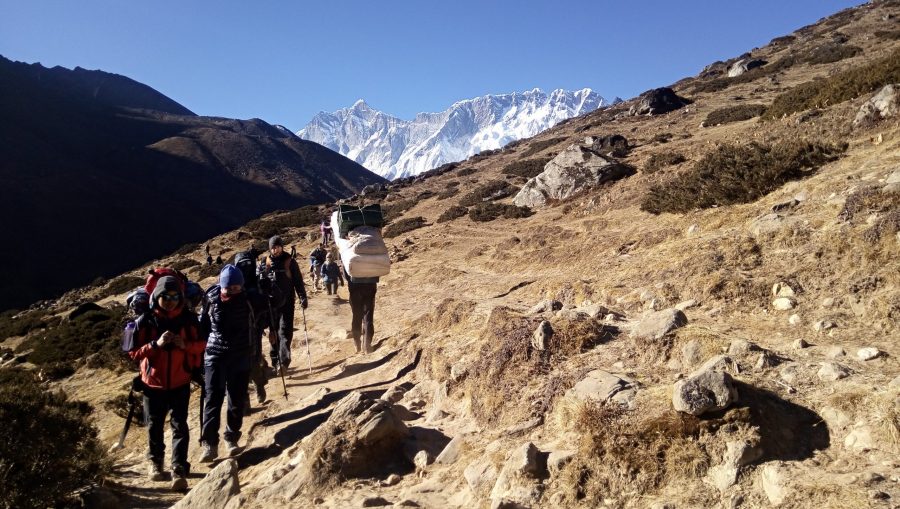
Near Pangboche
Overall, the Everest Base Camp trek is a popular destination among Indian tourists, and there are several trekking companies that offer quality services and experienced guides at reasonable prices. It’s recommended to research and compare different trekking companies and packages to find the best price for your budget. Additionally, it’s essential to ensure that the trekking company you choose provides quality services and experienced guides to ensure a safe and enjoyable trekking experience.
Annapurna Base Camp (ABC) and Everest Base Camp (EBC) are two of the most popular trekking destinations in Nepal. Here are some similarities and differences between the two treks:
Similarities:
Differences:
In conclusion, both the Annapurna Base Camp and Everest Base Camp treks offer unique experiences and challenges for trekkers. The choice between the two will depend on individual preferences, fitness levels, and available time and budget.
The cost of a Kathmandu to Lukla flight ticket for Indian tourists can vary depending on the airline, season, and availability. On average, the cost of a round-trip flight ticket from Kathmandu to Lukla for an Indian tourist cost about INR 18,000.
However, it’s important to note that the flight schedule to Lukla is often affected by weather conditions, and flights may be delayed or canceled, especially during the peak trekking season. It’s recommended to book your flight tickets in advance and be prepared for potential delays or cancellations.
Additionally, it’s essential to ensure that the airline you choose for your flight to Lukla has a good safety record and is reputable. It’s recommended to book your flight tickets through a reliable travel agency or directly through the airline’s website to ensure a safe and smooth journey.
If you’re looking to hire a mountain guide in Kathmandu and travel to Everest Base Camp, there are several reputable trekking companies that offer experienced and knowledgeable guides. Here are some steps to help you find the best mountain guide for your Everest Base Camp trek:
Overall, hiring a knowledgeable and experienced mountain guide is essential for a safe and enjoyable Everest Base Camp trek. Make sure to do your research and choose a reputable trekking company with experienced guides to ensure a memorable and rewarding trekking experience.
The cost of helicopter sharing from Kathmandu to Lukla can vary depending on the number of passengers sharing the helicopter, availability, and season. On average, the cost of helicopter sharing from Kathmandu to Lukla ranges from USD 500 to USD 600 per person for a one-way flight.
However, it’s important to note that helicopter flights to Lukla are often affected by weather conditions, and flights may be delayed or canceled, especially during the peak trekking season. Additionally, helicopter sharing may not always be available, and you may need to book a private helicopter at a higher cost.
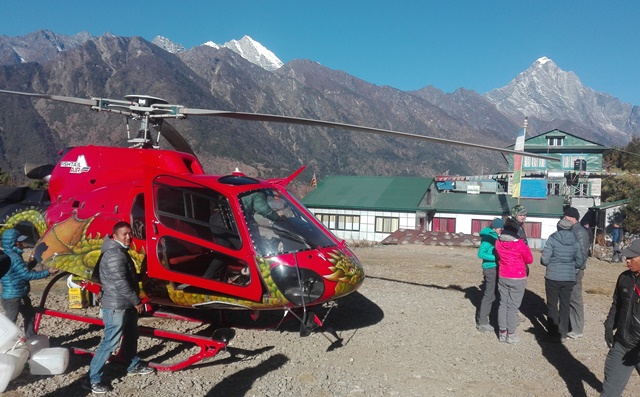
Mountain Flight on helicopter in Nepal
It’s recommended to book your helicopter flight in advance through a reliable travel agency or directly with the helicopter operator to ensure availability and confirm the price. Additionally, make sure to check the safety record and reputation of the helicopter operator before booking your flight.
Helicopter sharing price from Gorakshep to Lukla
The cost of helicopter sharing from Gorakshep to Lukla can vary depending on the number of passengers sharing the helicopter, availability, and season. On average, the cost of helicopter sharing from Gorakshep to Lukla ranges from USD 900 to USD 1000 per person for a one-way flight.
However, it’s important to note that helicopter flights are often affected by weather conditions, and flights may be delayed or canceled, especially during the peak trekking season. Additionally, helicopter sharing may not always be available, and you may need to book a private helicopter at a higher cost.
It’s recommended to book your helicopter flight in advance through a reliable travel agency or directly with the helicopter operator to ensure availability and confirm the price. Additionally, make sure to check the safety record and reputation of the helicopter operator before booking your flight.
The cost of helicopter sharing from Lukla to Kathmandu can vary depending on the number of passengers sharing the helicopter, availability, and season. On average, the cost of helicopter sharing from Lukla to Kathmandu ranges from USD 500 to USD 800 per person for a one-way flight.
However, it’s important to note that helicopter flights are often affected by weather conditions, and flights may be delayed or canceled, especially during the peak trekking season. Additionally, helicopter sharing may not always be available, and you may need to book a private helicopter at a higher cost.
It’s recommended to book your helicopter flight in advance through a reliable travel agency or directly with the helicopter operator to ensure availability and confirm the price. Additionally, make sure to check the safety record and reputation of the helicopter operator before booking your flight.
Overall, helicopter sharing from Lukla to Kathmandu can be a convenient and time-saving option for those with a limited schedule or who want to avoid the strenuous trek back to Lukla. However, it’s essential to ensure the safety and reliability of the helicopter operator to ensure a safe and enjoyable journey.
Flight cancellations due to weather conditions are common in Lukla, especially during the peak trekking season. In case your flight is canceled, there are several things you can do:
Yes, students can make the Everest Base Camp trek, provided they are physically fit and healthy. The trek is a challenging and strenuous journey that requires good physical fitness and stamina. However, with proper preparation, training, and guidance from experienced guides, students can successfully complete the trek and enjoy the breathtaking scenery and unique cultural experiences along the way.
It’s important to note that the Everest Base Camp trek involves trekking at high altitudes, which can cause altitude sickness in some people. Therefore, it’s essential to acclimatize properly and take necessary precautions to avoid altitude sickness.
If you’re a student planning to trek to Everest Base Camp, it’s recommended to train for several weeks before your trip by doing regular aerobic exercise, strength training, and hiking on hills and mountains. Additionally, it’s crucial to stay hydrated, eat nutritious food, and get enough rest during the trek to maintain your energy and stamina.
Furthermore, students should travel with an experienced guide and a reputable trekking agency that provides all necessary equipment, permits, and medical support. With proper preparation, guidance, and precautions, students can make the Everest Base Camp trek safely and enjoyably.
During the Everest Base Camp trek, you can expect to stay in tea houses or lodges along the trekking route. These are basic accommodations that offer a bed, a blanket, and a pillow. Tea houses are traditional Nepali guesthouses that offer a unique cultural experience, and they are an integral part of the trekking experience in Nepal.
Tea houses usually have shared rooms, and you may have to share a room with other trekkers. However, some tea houses offer private rooms for an additional cost. The rooms are basic, and they may not have attached bathrooms. Instead, there are communal bathrooms and toilets that you’ll need to share with other trekkers.
In terms of amenities, tea houses usually have a common dining area where you can order food and drinks. The food is typically simple, but it’s filling and nutritious. You can expect to find a variety of dishes such as rice, dal, vegetables, noodles, and soup. Most tea houses also serve tea, coffee, and other hot drinks.
During the peak trekking season, tea houses can get busy, and rooms may be fully booked. It’s recommended to book your accommodation in advance through a reputable trekking agency or your guide. Also, keep in mind that electricity and hot water may not be available at all times, and Wi-Fi may be limited or not available in some tea houses.
Overall, tea houses are basic but comfortable accommodations that offer a unique cultural experience and are an essential part of the Everest Base Camp trek.
Acclimatization is a crucial aspect of the Everest Base Camp trek, as it helps the body adjust to high altitudes and reduces the risk of altitude sickness. Namche Bazaar and Dingboche are two key acclimatization points on the trek, and there are several reasons why they are preferred over other places.
Namche Bazaar is the gateway to the Everest region and is located at an altitude of 3,440 meters (11,286 feet). This is a significant altitude gain from Lukla, which is the starting point of the trek. Spending a day or two in Namche Bazaar allows the body to adjust to the higher altitude and prepare for further ascents. Additionally, Namche Bazaar is a bustling market town that offers a unique cultural experience and stunning views of the surrounding mountains.
Dingboche is located at an altitude of 4,410 meters (14,468 feet) and is another crucial acclimatization point on the trek. The ascent from Namche Bazaar to Dingboche is steep, and spending a day in Dingboche helps the body acclimatize to the higher altitude. Dingboche also offers breathtaking views of the surrounding mountains, including Ama Dablam and Lhotse.
Other places on the trek may not be suitable for acclimatization due to their location or altitude. For example, Gorak Shep, which is the highest settlement on the trek, is located at an altitude of 5,164 meters (16,942 feet), and spending too much time there without proper acclimatization can increase the risk of altitude sickness.
In conclusion, Namche Bazaar and Dingboche are preferred acclimatization points on the Everest Base Camp trek & Kalapathar because they offer a suitable altitude for acclimatization and unique cultural experiences. Spending time at these places helps the body adjust to higher altitudes and reduces the risk of altitude sickness, which is essential for a safe and enjoyable trekking experience.
If you have some extra time after completing the 10 days Everest Base Camp trek, there are several places in the Everest region that you can explore. Here are some popular options:
These are just a few of the many options for exploring the Everest region after the Lukla to Everest Base Camp trek. It is essential to plan your itinerary carefully and consult with a local guide to ensure a safe and enjoyable trip.
Chola Pass and Gokyo Ri are both challenging but rewarding trekking destinations in the Everest region. Here’s a brief overview of their difficulty levels:
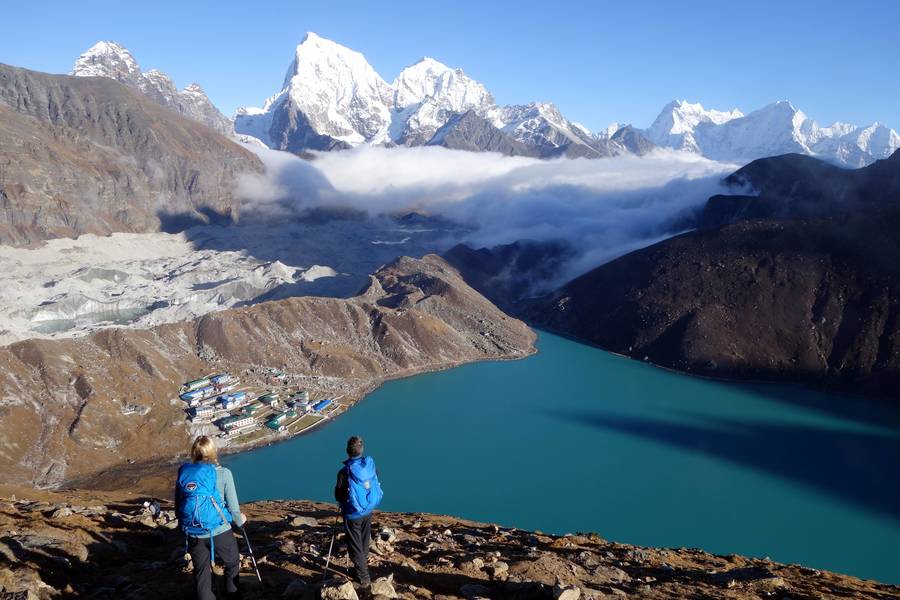
Overall, both Chola Pass and Gokyo Ri are challenging but rewarding treks that require a good level of fitness and previous trekking experience at high altitudes. It is recommended to have a local guide or trekking agency to ensure a safe and enjoyable experience.
While it is technically possible to trek from Lukla to Namche Bazaar in one day, it is generally not recommended as it can be quite challenging due to the altitude gain and the steep ascent involved.
The trek from Lukla to Namche Bazaar is approximately 9-10 kilometers (5-6 miles) long and involves an altitude gain of over 800 meters (2,600 feet). The trail is steep and can be strenuous, especially for those who are not acclimatized to the altitude.
It is recommended to take at least 2 days to complete the Lukla to Namche Bazaar trek to allow for proper acclimatization and to minimize the risk of altitude sickness. Many trekkers typically stop at Phakding or Monjo for the first night before continuing on to Namche Bazaar on the second day.
It’s always important to listen to your body and acclimatize properly during any high altitude trek. This will help you to enjoy the trek more and avoid altitude sickness.
Money exchange and ATMs are available in some of the larger towns along the Everest Base Camp trek, but they can be limited and unreliable. Here is some information about money exchange and ATMs in the Everest region:
Money Exchange: The most commonly accepted currency in Nepal is the Nepalese Rupee (NPR). Money exchange services are available in Kathmandu and some of the larger towns along the Everest Base Camp trek, such as Namche Bazaar and Lukla. However, exchange rates may vary and it’s always a good idea to shop around for the best rates. It is recommended to carry some US dollars or Euros in cash, which can be easily exchanged in Nepal.
ATMs: There are a few ATMs available along the Everest Base Camp trek in towns like Namche Bazaar, Phakding, and Lukla. However, they can be unreliable and may run out of cash or be out of service. It is always a good idea to carry some cash with you, as well as a credit card for emergencies. You should inform your bank that you will be traveling in Nepal to ensure that your card will work abroad and to avoid any issues with fraud prevention systems that may block your card.
Overall, it’s important to be prepared with enough cash for your trek and to carry a mix of currencies, including Nepalese Rupees and US dollars or Euros. It’s always a good idea to check exchange rates and ATM availability before heading out on the trek, and to carry some extra cash as a backup.
The view from Kalapatthar is one of the highlights of the Everest Base Camp trek, offering stunning panoramic views of the surrounding Himalayan peaks, including Mount Everest. Kalapatthar is a peak located at an altitude of 5,545 meters (18,192 feet) and is a popular destination for trekkers to view the sunrise or sunset over the Everest region.
From the summit of Kalapatthar, trekkers can enjoy a 360-degree view of the Himalayan range, including peaks like Pumori, Nuptse, Changtse, Lhotse, and, of course, Mount Everest. The view of Mount Everest from Kalapatthar is considered one of the best views of the mountain available to trekkers, as it provides an unobstructed view of the entire mountain from base to summit.
In addition to the stunning mountain views, Kalapatthar also offers views of the Khumbu Glacier and Icefall, as well as the surrounding valleys and villages. It is a challenging but rewarding climb to the top, and many trekkers say that the view from Kalapatthar is one of the most memorable experiences of their Everest Base Camp trek.
The Khumbu Icefall and Khumbu Glacier are located in the Khumbu region of the Himalayas in Nepal, and are part of the route that climbers take to reach the summit of Mount Everest.
The Khumbu Glacier is the largest glacier in Nepal, and is over 17 miles (28 km) long. It is located at an altitude of around 5,000 meters (16,000 feet), and is fed by the Western Cwm, a large glacial valley on the south side of Everest. The Khumbu Glacier is constantly moving, and is responsible for the creation of the Khumbu Icefall.
The Khumbu Icefall is a treacherous section of the Everest climbing route, consisting of large blocks of ice and crevasses that shift and move unpredictably. It is located at an altitude of around 5,500 meters (18,000 feet), and is considered one of the most dangerous sections of the climb. The icefall is constantly changing and moving due to the movement of the Khumbu Glacier, and climbers must navigate it carefully to avoid falling into crevasses or being struck by falling ice.
The history of the Khumbu Icefall and Khumbu Glacier is closely tied to the history of Mount Everest climbing expeditions. The first successful ascent of Everest was made in 1953 by Sir Edmund Hillary and Tenzing Norgay, and since then, thousands of climbers have attempted to reach the summit. The Khumbu Icefall and Khumbu Glacier have been major obstacles to climbers, and have claimed the lives of many over the years.
Despite the dangers posed by the Khumbu Icefall and Khumbu Glacier, they continue to attract climbers and trekkers to the region to experience the beauty and challenge of the Himalayas.
There are actually several permit check points along the Everest region trekking route.
The first permit check point is located in Monjo, which is a village located just before the entrance to the Sagarmatha National Park. All trekkers must have a valid permit to enter the park, and the permit is checked at the entry gate in Monjo.
The second permit check point is located in Namche Bazaar, which is the largest village in the Everest region and a popular resting spot for trekkers. This check point is used to verify that trekkers have valid permits to enter the park.
The third permit check point is located at the village of Phakding, just before the village of Lukla. This check point is used to ensure that trekkers leaving the park have valid permits.
In addition to these permit check points, there are also occasional permit checks along the trekking route by park officials or the Nepalese Army. These checks are usually random and designed to deter trekkers from attempting to trek without a valid permit.
The Everest Base Camp 12 days Trek is a popular choice for first-time trekkers in Nepal, as it offers an unforgettable experience of trekking in the world’s highest mountain range. However, it is also important to be prepared for the challenges that come with high altitude trekking.
Here are some tips for first-time trekkers planning to undertake the Everest Base Camp Trek:
The Everest Base Camp Trek is an amazing adventure and a great way to explore the beautiful Himalayan region of Nepal. By preparing well, staying safe, and respecting the local culture, first-time trekkers can have an unforgettable experience on this trek.
The Everest Base Camp trek offers a variety of dining options to choose from. Here are some of the best places to eat during the trek:
It’s important to note that the dining options may be limited and basic in the higher altitudes, and the prices may be higher due to the difficulty of transportation and availability of supplies. Additionally, it’s recommended to avoid meat and dairy products as they may not be fresh and hygienic. It’s always a good idea to bring some snacks and energy bars with you to ensure you have enough food during the trek.
Altitude mountain sickness (AMS) is a condition caused by the decreased oxygen levels at high altitudes, which can affect anyone regardless of age, gender, or fitness level. Here are some of the symptoms of altitude mountain sickness:
If you experience any of these symptoms, it’s important to take action immediately to prevent further complications. Here are some steps you can take to prevent altitude mountain sickness:
It’s important to recognize the symptoms of altitude mountain sickness early and take the necessary steps to prevent further complications. By following these guidelines, you can have a safe and enjoyable trekking experience in the Everest region.
Nangkartshang Peak and Chhukung Ri are two popular viewpoints in the Everest region that offer stunning panoramic views of the surrounding mountains, including Mount Everest.
Nangkartshang Peak is a small hill located above Dingboche village at an elevation of 5,083 meters. It is a popular acclimatization hike for trekkers heading towards Everest Base Camp. The trek to Nangkartshang Peak involves a steep climb and takes about 3-4 hours to reach the top. From the top, trekkers can enjoy breathtaking views of the entire Imja Valley, including Ama Dablam, Island Peak, Makalu, and Lhotse.
Chhukung Ri, on the other hand, is a rocky peak situated at an elevation of 5,550 meters above the Chhukung village. The trek to Chhukung Ri involves a steep climb and takes about 6-7 hours to reach the top. From the top, trekkers can enjoy breathtaking views of Mount Everest, Lhotse, Nuptse, Makalu, and several other peaks. The panoramic views from the top of Chhukung Ri are considered to be some of the best in the entire Everest region.
Both Nangkartshang Peak and Chhukung Ri are excellent viewpoints, and the choice between the two may depend on individual preferences and time constraints. Nangkartshang Peak is relatively easier and quicker to climb and is an excellent option for trekkers who want to acclimatize at a slower pace, while Chhukung Ri is a more challenging climb but offers more expansive views. It’s important to note that both hikes require proper acclimatization and trekking gear to ensure a safe and enjoyable experience.
How to reserve accommodation in Everest base camp duing peak season
During the peak season (September to November and March to May), it can be challenging to reserve accommodation in advance as there is high demand. However, there are a few options available to ensure you have a place to stay:
It’s always a good idea to do some research and plan ahead as much as possible to ensure a comfortable and enjoyable trekking experience.
During the Everest Base Camp trek, trekkers can see four of the world’s highest mountains over 8,000 meters (26,247 feet): Mount Everest (8,848 meters/29,029 feet), Lhotse (8,516 meters/27,940 feet), Makalu (8,485 meters/27,838 feet), and Cho Oyu (8,188 meters/26,864 feet). In addition, trekkers can also see other stunning peaks such as Ama Dablam, Thamserku, Kangtega, and Pumori, among others. The views of these majestic peaks are one of the main reasons why the Everest Base Camp trek is so popular among trekkers from around the world.
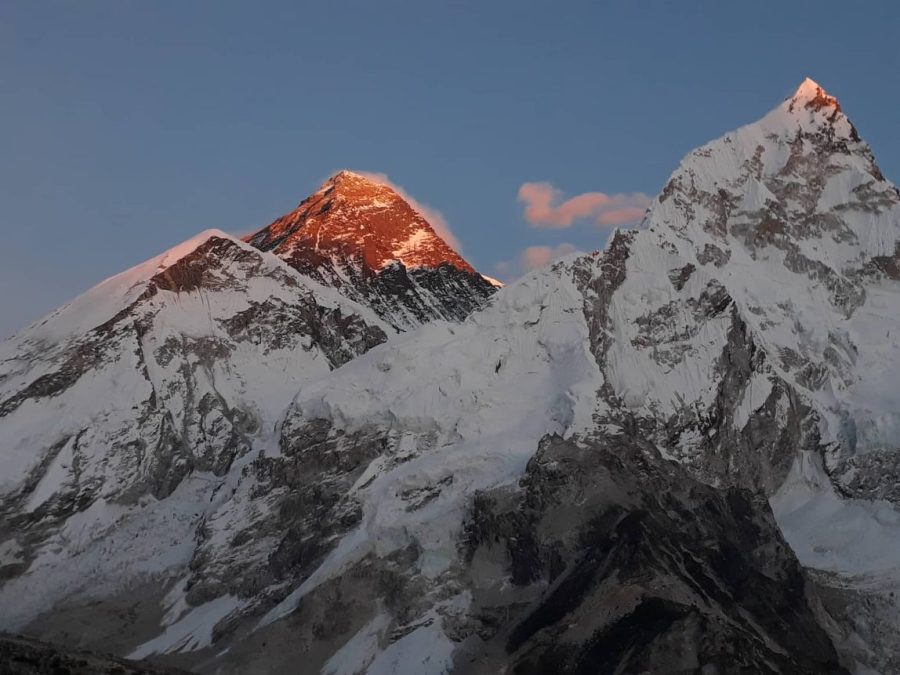
Kalapathar is located about 1.5 miles (2.4 kilometers) from Gorakshep, which is the last settlement on the Everest Base Camp trek. It takes about 2-3 hours to trek from Gorakshep to Kalapathar, depending on your pace and fitness level. The trail is steep and rocky, with an elevation gain of approximately 550 feet (168 meters) from Gorakshep to the summit of Kalapathar (18,192 feet/5,545 meters). However, the stunning views of Mount Everest, the Khumbu Glacier, and other peaks from the top of Kalapathar are well worth the effort.
The distance from Gorakshep to Everest Base Camp and back is approximately 5.5 miles (8.8 kilometers) round trip. The trail from Gorakshep to Everest Base Camp is mostly flat and follows the Khumbu Glacier, passing by rocky terrain and moraine hills. The trek takes about 2-3 hours each way, depending on your pace and fitness level. It’s important to note that the trail can be challenging due to the high altitude and rugged terrain, so it’s essential to acclimatize properly and take breaks as needed. Additionally, the weather conditions can change quickly, so it’s important to be prepared with appropriate gear and equipment.
The distance covered during the 12-day Lukla to Everest Base Camp trek is approximately 70 miles (112 kilometers). This includes the round trip from Gorakshep to Everest Base Camp and the hike to Kala Patthar.
On the first day, you will fly from Kathmandu to Lukla, and from there, you will trek to Phakding, covering a distance of about 6.2 miles (10 kilometers). The next day, you will trek to Namche Bazaar, covering a distance of about 6.8 miles (11 kilometers).
From Namche Bazaar, you will trek to Tengboche, Dingboche, Lobuche, and Gorakshep, covering distances of approximately 6.8 miles (11 kilometers), 7.5 miles (12 kilometers), 7.5 miles (12 kilometers), and 4.3 miles (7 kilometers), respectively.
On the day of the Everest Base Camp hike, you will cover a distance of about 5.5 miles (8.8 kilometers) round trip from Gorakshep. The next day, you will hike to Kala Patthar, which is about 1.8 miles (3 kilometers) from Gorakshep.
After visiting Kala Patthar, you will retrace your steps back to Lukla, following the same route, and covering a distance of approximately 35.5 miles (57 kilometers) over four days.
It’s important to note that the distances may vary depending on the exact route taken, weather conditions, and individual pace. Additionally, it’s essential to acclimatize properly, take breaks as needed, and stay hydrated during the trek.
If you are planning to hire a porter for your Everest Base Camp trek from Lukla, there are several options available. You can either arrange for a porter through a trekking agency or hire one on your own at Lukla.
If you choose to hire a porter through a trekking agency, they will typically arrange for a porter for you based on the number of bags you have and the duration of your trek. The porter will usually cost around $20 to $30 per day and will carry up to 25 kg of your belongings. It’s important to note that you should choose a reputable agency that hires only licensed porters who are insured and provided with proper equipment.
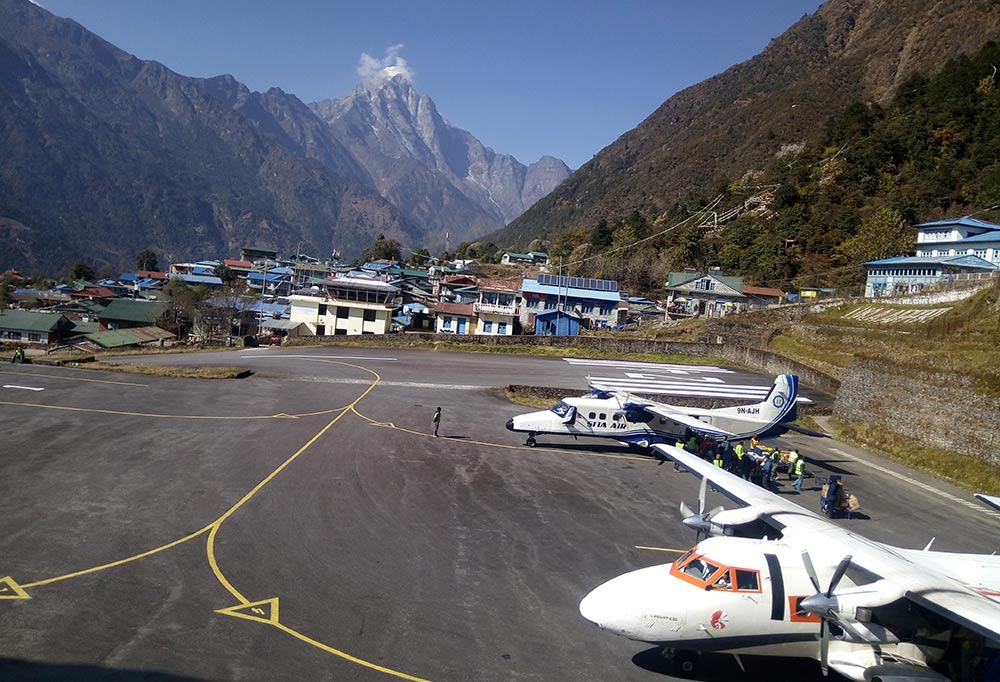
If you prefer to hire a porter on your own at Lukla, you can find porters waiting for work at the Lukla airport or in Lukla village. You can negotiate with them directly for a daily rate, which is usually around $15 to $25 per day, depending on the season and the number of bags you have. Keep in mind that it’s important to ensure that the porter is licensed and insured before hiring them, and it’s also a good idea to check their equipment to make sure they are properly equipped for the trek.
Overall, hiring a porter can be a great option for those who want to enjoy the trek without carrying a heavy load, and it also provides a source of income for the local community.